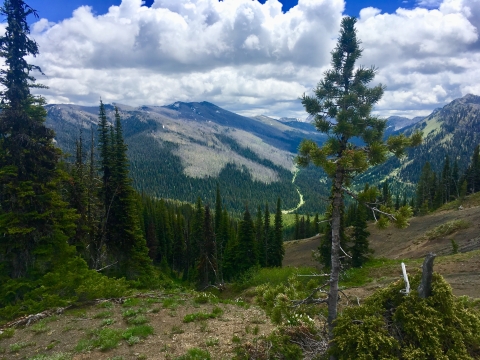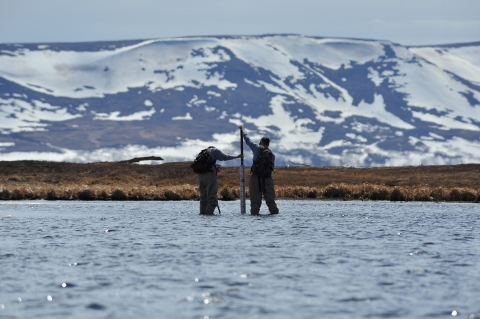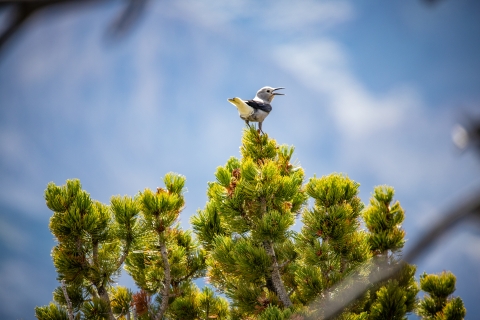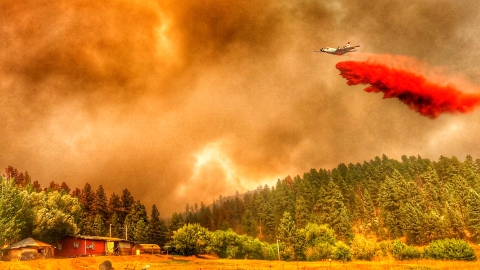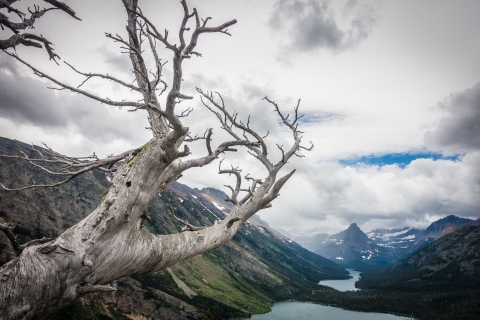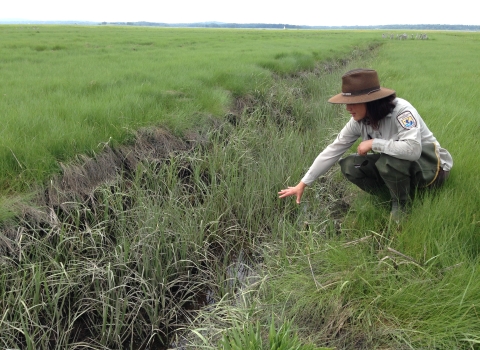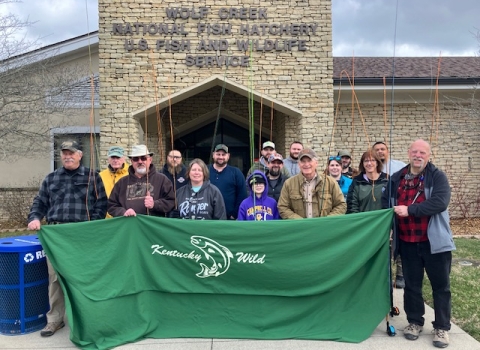Service scientists are truly superheroes, protecting our wild spaces and saving species from extinction. To make these daring rescues, they first need to know what they’re up against.
While our heroes don’t have the power to see into the future, with the help of climate models, they’re protecting wildlife and plants like the whitebark pine from future harm.
The power of the ESA
The Endangered Species Act is incredibly effective, saving 99% of listed species from extinction. It protects listed species from actions that may lead to their death or harm, including direct actions like poaching and indirect actions like destruction of the habitats these species call home.
But what does it mean to make the list?
Under the ESA, species may be listed as threatened or endangered. Endangered means a species is likely to completely disappear or go extinct in the near future. Threatened means a species is likely to become endangered in the near future.
So, as the planet warms, how do scientists project potential changes in the landscape and how species will respond?
They use models that gather information from around the world on trends in greenhouse gas emissions, human population-growth and development, and more to determine a range of likely future conditions.
Species-specific
Dotting mountainsides along ranges such as the Sierras and Rockies, majestic, crown-shaped whitebark pine trees grow 16 to 66 feet tall. Whitebark pine is a keystone or foundational species, meaning its existence is necessary to maintain the health of its environment and the species that live there. These evergreens stabilize soil, slow snow-melt, reduce flooding and provide food for many seed-eating animals. They typically thrive in cold, windy forests at high elevations and are known to live for 500 to 1,000 years.
But in December 2022, the Service listed whitebark pine as a threatened species, in part because of how climate change climate change
Climate change includes both global warming driven by human-induced emissions of greenhouse gases and the resulting large-scale shifts in weather patterns. Though there have been previous periods of climatic change, since the mid-20th century humans have had an unprecedented impact on Earth's climate system and caused change on a global scale.
Learn more about climate change is expected to impact its habitat.
For all ESA listings, Service scientists compile the best available information on the species’ characteristics, life history and habitat. Then they look at the current condition of the species, including its abundance, range and genetic variation.
Current population health, genetic make-up and range all influence whether the species as a whole can withstand changes in its environment. More populations and a larger range allow for certain populations or areas to experience losses without the species as a whole disappearing. However, genetic variability that helps account for adaptive responses to changing conditions may be lost; the genetic difference between one tree and the next may be the reason why one tree survives stressors like disease and another does not.
Service Endangered Species Biologist Dr. Brenna Forester explained, “Service biologists are continually learning and adapting to new information, so the best-available scientific information is used to inform ESA decisions."
When looking at listing whitebark pine, scientists first considered the tree’s reproductive cycle and decided they should model for 180 years, or three generations, rather than the 75-year standard for most climate-change modeling. By looking at generations rather than years, they can better understand how the species will respond to change over time.
Model projections show scientists how whitebark pine habitat may change in those 180 years. Combined with the data on current status, this insight informs listing decisions.
Where does this information come from?
Climate change is one of the greatest environmental stressors we face today. To better understand the challenges wildlife and plants will have to overcome, our scientists look at information gathered globally.
The Service relies on the Intergovernmental Panel on Climate Change, created by the United Nations in 1988. The IPCC provides governments with information on what is causing climate change, how this change will impact our planet, the future risks associated with this change, and how these risks can be reduced. They gather the best available science from around the world, and regional experts from different global regions review the information to make sure it’s objective and complete.
Scientists plug this climate data into models that simulate climate processes, using current trends to make projections about future changes.
For example, scientists know the world’s oceans are warming by 0.27°F per decade because they have been measuring ocean temperatures for more than a century. A climate model can use that information to project ocean temperatures 50 or 100 years from now.
These models can also help us account for uncertainties that might change projected outcomes, like how quickly and effectively the world reduces global greenhouse gas emissions and how the climate system responds to those reductions. These climate scenarios help us compare how climate conditions may change depending on things like population growth, economic growth and changes in technology.
Global models can be downscaled to look at unique locations with specific features — like the Gulf of Maine, which is warming faster than the rest of the world’s oceans — to understand how landscape features, like hills and river valleys, change local climate patterns.
“Models can be simple or complex depending on how much information we have,” Dr. Forester said. “In either case, they are critical to ensuring a clear, transparent, and repeatable approach to assessing extinction risk.”
A lifetime of needs
When evaluating a species for listing, we identify its needs for all life stages. Whitebark pine seeds need cold weather to start to grow, but mature trees need two summers of warmer temperatures and enough rain to mature. From there, scientists dive deeper into the habitat and resources a species relies on to better understand how potential changes at a location may have a domino effect on the species in question.
Whitebark pine has multiple stressors that could influence its survival, including diseases such as white pine blister rust, which damages stems and cone-bearing branches and restricts nutrient flow until the tree eventually dies. Models project that within 10 to 20 years all whitebark pine trees will be infected with white pine blister rust.
Additionally, mountain pine beetles have been attacking these trees in record numbers — the trees’ only defense is low winter temperatures that can kill beetle larvae and adults. At their high elevation, whitebark pines used to be protected. But as winters shorten and temperatures rise, mountain pine beetles are now thriving at higher and higher elevations. The safe areas for whitebark pines are shrinking.
Fortunately for the trees, Clark’s nutcrackers might swoop in and save them. These crow-like birds have specialized beaks to extract seeds from whitebark pinecones. The nutcrackers carry the seeds for miles before storing them — effectively planting them in the ground.
But the relationship between the birds and the trees is not equal. Clark’s nutcrackers can also extract seeds from other pine species. With food available elsewhere, it’s highly likely that, as temperatures increase, Clark’s nutcrackers will move to cooler areas, leaving whitebark pine trees behind with no way to migrate.
How accurate are these models?
Humans are uniquely able to change the world at both local and global scales. Our actions as individuals and as a species are unpredictable. This is why we model scenarios that consider a range of potential human choices.
Because humans can change on a whim, we can only lay out probable scenarios; we can’t determine which are more likely to happen.
However, we do have confidence that the scenarios we currently use accurately project future conditions up to the year 2100 for most climate change information. How, might you ask?
When people think about climate change, they often consider it a future problem, yet right now we are experiencing the results of a changing climate, including an increase in extreme weather events, sea-level rise, droughts and wildfires.
Climate models have produced accurate hindcasts of climate change in the last century. In a hindcast, a model is tested by comparing its results to see if they match actual historical records. The success of these tests gives us confidence that the models will continue to accurately project the effects of climate change.
Climate and conservation
Climate models help us determine not only which species need immediate protection but also what actions are necessary to protect them. Modeling helps scientists weigh restoration projects based on their likelihood of success. The models combine all the existing knowledge to determine what locations and actions will lead to the best results.
For whitebark pines, it’s not as simple as helping those populations under the most stress. In an area with trees infected with white pine blister rust, for example, newly planted seedlings would likely die off quickly. A population with fewer stressors, on the other hand, may benefit from planting trees.
Meanwhile, that same disease-stressed population could contain individual trees with a genetic advantage for surviving the rust. Rather than planting more trees, we could do more for that population and the species by conducting genetic studies to look for and propagate rust-resistant trees.
Looking ahead
In 2023, we celebrated the 50th anniversary of the Endangered Species Act. As a scientific community, the Service and its partners have come a long way from the decision-making of the past.
“I have hope because of the 50 years of conservation successes under the ESA,” Dr. Forester said. “The ESA is one of the most powerful and effective environmental laws in the world. One of the major reasons it has been so successful is the incredibly talented and dedicated scientists and policy experts who work for the U.S. Fish and Wildlife Service. We all work together to continually innovate and improve how we apply science and policy to protect species from extinction — something which is needed now more than ever.”
Advances in technology like climate modeling help these dedicated individuals break down the extremely complex questions of which species need protection and how we can best protect them.
Though we can’t see into the future, it is clear, with the continued advancement of technology and the commitment of our super scientists across the country, the next 50 years of the Endangered Species Act will be full of success stories and, most importantly, hope.


